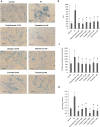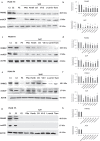Therapeutic approach with commercial supplements for pantothenate kinase-associated neurodegeneration with residual PANK2 expression levels
- PMID: 35945593
- PMCID: PMC9364590
- DOI: 10.1186/s13023-022-02465-9
Therapeutic approach with commercial supplements for pantothenate kinase-associated neurodegeneration with residual PANK2 expression levels
Abstract
Background: Neurodegeneration with brain iron accumulation (NBIA) is a group of rare neurogenetic disorders frequently associated with iron accumulation in the basal nuclei of the brain characterized by progressive spasticity, dystonia, muscle rigidity, neuropsychiatric symptoms, and retinal degeneration or optic nerve atrophy. Pantothenate kinase-associated neurodegeneration (PKAN) is one of the most widespread NBIA subtypes. It is caused by mutations in the gene of pantothenate kinase 2 (PANK2) that result in dysfunction in PANK2 enzyme activity, with consequent deficiency of coenzyme A (CoA) biosynthesis, as well as low levels of essential metabolic intermediates such as 4'-phosphopantetheine, a necessary cofactor for essential cytosolic and mitochondrial proteins.
Methods: In this manuscript, we examined the therapeutic effectiveness of pantothenate, panthetine, antioxidants (vitamin E and omega 3) and mitochondrial function boosting supplements (L-carnitine and thiamine) in mutant PANK2 cells with residual expression levels.
Results: Commercial supplements, pantothenate, pantethine, vitamin E, omega 3, carnitine and thiamine were able to eliminate iron accumulation, increase PANK2, mtACP, and NFS1 expression levels and improve pathological alterations in mutant cells with residual PANK2 expression levels.
Conclusion: Our results suggest that several commercial compounds are indeed able to significantly correct the mutant phenotype in cellular models of PKAN. These compounds alone or in combinations are of common use in clinical practice and may be useful for the treatment of PKAN patients with residual enzyme expression levels.
Keywords: Acyl carrier protein; Carnitine; Coenzyme A; Omega 3; Pantethine; Pantothenate; Pantothenate kinase; Pantothenate kinase-associated neurodegeneration; Thiamine; Vitamin E.
© 2022. The Author(s).
Conflict of interest statement
The authors declare that the research was conducted in the absence of any commercial or financial relationships that could be construed as a potential competing interest.
Figures








Similar articles
-
Patient-Derived Cellular Models for Polytarget Precision Medicine in Pantothenate Kinase-Associated Neurodegeneration.Pharmaceuticals (Basel). 2023 Sep 26;16(10):1359. doi: 10.3390/ph16101359. Pharmaceuticals (Basel). 2023. PMID: 37895830 Free PMC article. Review.
-
Down regulation of the expression of mitochondrial phosphopantetheinyl-proteins in pantothenate kinase-associated neurodegeneration: pathophysiological consequences and therapeutic perspectives.Orphanet J Rare Dis. 2021 May 5;16(1):201. doi: 10.1186/s13023-021-01823-3. Orphanet J Rare Dis. 2021. PMID: 33952316 Free PMC article.
-
Alpha-lipoic acid supplementation corrects pathological alterations in cellular models of pantothenate kinase-associated neurodegeneration with residual PANK2 expression levels.Orphanet J Rare Dis. 2023 Apr 12;18(1):80. doi: 10.1186/s13023-023-02687-5. Orphanet J Rare Dis. 2023. PMID: 37046296 Free PMC article.
-
A therapeutic approach to pantothenate kinase associated neurodegeneration: a pilot study.Orphanet J Rare Dis. 2024 Nov 28;19(1):442. doi: 10.1186/s13023-024-03453-x. Orphanet J Rare Dis. 2024. PMID: 39609877 Free PMC article.
-
Rational Design of Novel Therapies for Pantothenate Kinase-Associated Neurodegeneration.Mov Disord. 2021 Sep;36(9):2005-2016. doi: 10.1002/mds.28642. Epub 2021 May 18. Mov Disord. 2021. PMID: 34002881 Review.
Cited by
-
Case report: Asymmetric bilateral deep brain stimulation for the treatment of pantothenate kinase-associated neurodegeneration in a patient: a unique case of atypical PKAN with a novel heterozygous PANK2 mutation.Front Hum Neurosci. 2024 Oct 16;18:1448606. doi: 10.3389/fnhum.2024.1448606. eCollection 2024. Front Hum Neurosci. 2024. PMID: 39479227 Free PMC article.
-
Patient-Derived Cellular Models for Polytarget Precision Medicine in Pantothenate Kinase-Associated Neurodegeneration.Pharmaceuticals (Basel). 2023 Sep 26;16(10):1359. doi: 10.3390/ph16101359. Pharmaceuticals (Basel). 2023. PMID: 37895830 Free PMC article. Review.
-
Inherited Disorders of Coenzyme A Biosynthesis: Models, Mechanisms, and Treatments.Int J Mol Sci. 2023 Mar 21;24(6):5951. doi: 10.3390/ijms24065951. Int J Mol Sci. 2023. PMID: 36983025 Free PMC article. Review.
-
Pathology and treatment methods in pantothenate kinase-associated neurodegeneration.Postep Psychiatr Neurol. 2024 Sep;33(3):163-171. doi: 10.5114/ppn.2024.141713. Epub 2024 Jul 23. Postep Psychiatr Neurol. 2024. PMID: 39678459 Free PMC article. Review.
-
Antioxidants Prevent Iron Accumulation and Lipid Peroxidation, but Do Not Correct Autophagy Dysfunction or Mitochondrial Bioenergetics in Cellular Models of BPAN.Int J Mol Sci. 2023 Sep 26;24(19):14576. doi: 10.3390/ijms241914576. Int J Mol Sci. 2023. PMID: 37834028 Free PMC article.
References
Publication types
MeSH terms
Substances
LinkOut - more resources
Full Text Sources

